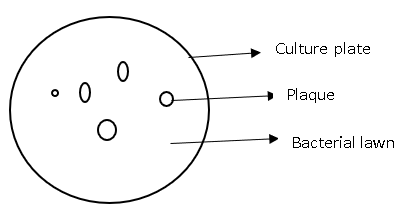This set of Virology Multiple Choice Questions & Answers (MCQs) focuses on “Methods of Culturing Viruses”.
1. Which of the following is an important requirement for culturing viruses?
a) Antibiotics
b) Prions
c) Antivirals
d) Host cells
View Answer
Explanation: Viruses are unable to reproduce outside the living cells. So, viruses cannot be cultured in the absence of host cells. Lytic bacterial and archaeal viruses can be cultured easily if the host cell can be grown in culture. Cells and viruses are mixed together in broth culture. Cells are infected and lysed by the viruses, releasing virions into the broth.
2. Which of the following can be used as host cells for culturing animal viruses?
a) Chicken eggs
b) Seeds
c) Wood
d) Leaves
View Answer
Explanation: Animal viruses are often cultivated by inoculating embryonated eggs. Fertilized chicken eggs incubated about 6 to 8 days after laying are inoculated with viruses. Seeds, wood, leaves are parts of plants. So, they cannot be used for culturing animal viruses. Animal viruses can also be grown in tissue culture on monolayers of animal cells.
3. What can be observed by naked eye in a virus culture?
a) Viroid
b) Virions
c) Viral plaques
d) Virus capsid
View Answer
Explanation: Viral plaques are areas without any cellular growth in a lawn of bacterial cells or monolayer of eukaryotic cells, formed after viral infection. The virus causes the host cells to lyse after infection, resulting in the formation of plaques. The number of infectious virus particles in a sample can be determined by counting the number of plaques.
4. Which of the following cultures is used for cultivating corona viruses?
a) Organ culture
b) Callus culture
c) Anther culture
d) Protoplast culture
View Answer
Explanation: Organ cultures are thin slices of organs preserved in vitro. Corona viruses are respiratory viruses. So, organ cultures with ciliated respiratory epithelium are used for the cultivation of corona viruses. Callus culture, another culture, protoplast culture are types of plant tissue cultures. So, they cannot be used for corona virus cultivation because it is an animal virus.
5. What is used to suppress mycoplasma contamination in virus cultures?
a) Abacavir
b) Kanamycin
c) Peramivir
d) Zanamivir
View Answer
Explanation: Mycoplasmas are prokaryotes that grow below the cytoplasmic membrane. Cell lines used for virus cultures are commonly contaminated with mycoplasmas. Kanamycin is an antibiotic which can be used to suppress mycoplasma contamination in virus cultures. Abacavir, Peramivir, Zanamivir are antivirals. They cannot be used to prevent mycoplasma contamination.
6. Which of the following can be used as a host to isolate influenza A virus?
a) Mice
b) Monkey
c) Hen’s eggs
d) Guineapig
View Answer
Explanation: Cultivation of viruses in embryonated hen’s eggs is used for the isolation of influenza A virus and production of a vaccine against this virus. Influenza A virus can be isolated after inoculation into the amnion sac of the egg. Vaccines against influenza A virus can be prepared after the inoculation of the virus into the allantois of the egg.
7. Which of the following hosts is used to study the oncogenic properties of viruses?
a) Mice
b) Human
c) Monkey
d) Bird
View Answer
Explanation: Mice are used primarily for studies of the oncogenic properties of viruses. The advantage of using mice is the availability of inbred strains. Mice belonging to an inbred strain are genetically identical. So, they show uniform susceptibility to infections and normal and tumor cells can be transplanted from one animal to the other without the development of any rejection reaction.
8. Which part of the chicken’s egg is used for the cultivation of poxviruses?
a) Allantois
b) Amniotic sac
c) Shell membrane
d) Chorioallantoic membrane
View Answer
Explanation: The chorioallantoic membrane of the chicken’s egg is highly susceptible to infection with poxviruses. So, it is used for their isolation and quantification. During infection newly synthesized virus spreads from the primarily infected cells to neighboring cells to form localized lesions called pocks.
9. Virus particles are present in the culture plate shown in the below diagram.

a) True
b) False
View Answer
Explanation: Formation of plaques can be observed in the diagram. After viral infection, areas without any cellular growth are formed in the lawn of bacterial cells because the viruses cause the bacterial cells to lyse. These clear areas are called plaques. So, infectious virus particles are present in the culture plate.
10. How much time is required after inoculation for the appearance of virus particles in plant cells?
a) 24 hours
b) 10 hours
c) 36 hours
d) 48 hours
View Answer
Explanation: The first intact virus particles appear in plant cells approximately 10 hours after inoculation. The virus particles can exist singly or in groups. It may also form amorphous or crystalline inclusion bodies within the cell areas (cytoplasm, nucleus) in which they are present.
11. Which of the following methods is used to grow virus in whole plants?
a) Protoplast culture
b) Mechanical inoculation
c) Anther culture
d) Tissue culture
View Answer
Explanation: Viruses can be grown in whole plants by mechanical inoculation. The leaves are mechanically inoculated by rubbing them with a mixture of virus particles and an abrasive. The cell walls are broken by the abrasive, which helps the virions to directly come in contact with the plasma membrane and infect the exposed host cells.
12. Which culture media is used to grow HeLa cells?
a) DMEM
b) Agar media
c) MS media
d) LS media
View Answer
Explanation: HeLa cells are derived from female cervix carcinoma and used as host cells to cultivate many viruses. Human papillomavirus (HPV) is studied using the HeLa cells. HeLa cells are also used as host cells for the development of HPV vaccine. Dulbecco’s Modified Eagle medium (DMEM) is commonly used for culturing HeLa cells.
13. Vero cell line is derived from which of the following animals?
a) African elephant
b) African lion
c) African leopard
d) African green monkey
View Answer
Explanation: Vero cells are cell lines derived from the kidney tissue of an African green monkey in the year 1962, at Chiba University in Japan. These cells are used for cultivation of some human viruses, like polio virus and rabies virus. Vero cells have a reduced capacity to synthesize interferon. So, Vero cells are suitable for cultivation of viruses which shows a high sensitivity to interferon.
14. Which of the following organisms should be used as a host to study the process of virus diseases in human?
a) Fish
b) Bird
c) Monkey
d) Tree
View Answer
Explanation: The species chosen to study the different steps in the viral disease process and the different defense reactions in human body should be closely related genetically to man. This is because certain infectious agents cannot replicate in more distantly related species. Therefore, monkeys are used to analyze the disease process in connection with infections caused by viruses.
15. All established cell lines have equal susceptibility to viruses.
a) True
b) False
View Answer
Explanation: The established cell lines show different rates of susceptibility to infection from different viruses. The cell line that is most suitable for culturing a virus should be determined before culturing the virus. The susceptibility of cells to a virus can be increased by treatment of the virus inoculum and the host cell with proteolytic enzymes.
Sanfoundry Global Education & Learning Series – Virology.
To practice all areas of Virology, here is complete set of 1000+ Multiple Choice Questions and Answers.
If you find a mistake in question / option / answer, kindly take a screenshot and email to [email protected]
- Apply for Biotechnology Internship
- Practice Biotechnology MCQs
- Check Virology Books
- Check Biotechnology Books
